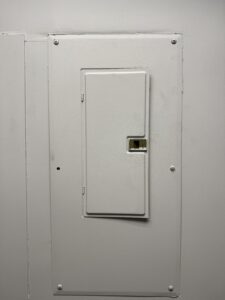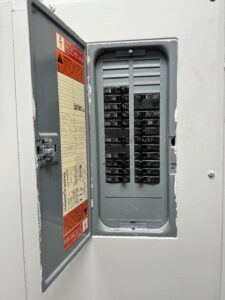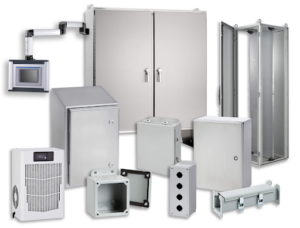Imagine this scenario: You’re making a smoothie with the TV blaring and the dishwasher humming along, all powered by a single fuse.
All of a sudden, silence. A fuse has blown. Naturally, your toddler starts crying because Cocomelon is no longer on the TV, prompting the dog to join in with barking.
To put these awful noises to a stop, you run down to your electrical box, open it up, and switch the circuit breaker. Peace is restored.


Source: HESCO
You’ve probably experienced this at least once in your life — maybe even more than once. But, what’s crucial to note here is that you need to open your electrical box to fix the issue. Meaning, your electrical components that run your household are in a closed metal box, saving the fuses from seeing any harm, like getting wet or dusty.
The storage location of electrical components is what is referred to as an enclosure — whether you’re in a home basement or in a manufacturing facility. The size changes, but the basic idea is the same. While the enclosures in your home and in a manufacturing center may vary greatly in size and functionality, they share key similarities, including being highly recommended and often mandatory for keeping your electrical supply safe.
But, what in the world does this have to do with manufacturing?
At HESCO, we’ve worked with nVENT Hoffman to distribute enclosures for more than 60 years. Our team dedicates itself to acquiring extensive knowledge on why enclosures are important in every manufacturing facility.
Let’s dive into what an enclosure is so you can be fully knowledgeable about electrical enclosures and why they are so important to have in your facility.
So, What Is an Enclosure?

Source: Automation Ready Panels
An enclosure is a structure designed to protect electrical controls from harmful environment conditions. These conditions could be dust, moisture, or high temperatures, all of which can compromise the functionality of electrical components inside of the enclosure.
Because the environment of your facility may greatly differ from another, enclosures are constructed using a range of materials, including metal, fiberglass, and plastic. These varied materials and constructions correspond to different NEMA ratings.
Understanding NEMA Ratings
NEMA (National Electrical Manufacturers Association) ratings are a system that defines what environmental factors an electrical enclosure can withstand.
Let’s go through a few of the different NEMA ratings so you understand how they are standardized to different environments.
NEMA 1
Primarily designed for indoor use, NEMA 1 enclosures ultimately provide you with protection against hazardous components. Additionally, there is protection for falling dirt and accidental contact by employees.
Typical Use: The most basic level of protection — anything from industrial control panels to A/V equipment can be stored in a NEMA 1 enclosure.
NEMA 2
Similar to NEMA 1, NEMA 2 is primarily for indoor use and prioritizes protection for employees from any hazardous parts. They also protect equipment inside against light water damage and falling dirt.
Typical Use: One step up from NEMA 1, this enclosure is capable of withstanding light water damage (dripping or light splashing). Usually, electrical components are housed here.
NEMA 3
Suitable for both indoor and outdoor applications, NEMA 3 enclosures provide enhanced protection for employees and equipment alike. These enclosures can withstand falling dirt, windblown dust, rain, sleet, and snow.
Typical Use: NEMA 3 enclosures are commonly employed to house electrical components exposed to outdoor conditions, such as generator skids. These skids serve as the primary base for generators and require robust protection against environmental elements.
These ratings represent just a fraction of the 20 NEMA ratings that are associated with electrical enclosures. Each one is different and unique, but all have the main goal of keeping employees safe.
Let’s apply this to an example. Picture a facility where they manufacture custom woodwork products. There are numerous saws and wood-cutting machines that create a significant amount of sawdust. While employees are protected with masks, the electrical components also need protection to prevent sawdust from disrupting the controls.
In this facility, you notice wall-mounted enclosures housing the electrical and industrial automation controls. These enclosures effectively shield the components from sawdust, eliminating potential hazards that could compromise the facility’s functionality or put the employees in danger.
This diminishes room for there to be any potential hazards that would negatively impact the overall functionality of the facility, or put any employees in the facility into harm’s way.
Since there is no risk of water exposure in this environment, the electrical enclosure is quite basic, classified as a NEMA 1.
Electrical Enclosure Providers
Now that you understand what an enclosure is and how they vary based on NEMA ratings, you might be wondering which provider is best suited for your needs. Here are a few top recommendations for high-quality electrical enclosures:
1. nVENT Hoffman
As we mentioned earlier, HESCO partners with nVENT Hoffman to distribute their enclosures. Formerly known as Hoffman, a pentair company, Hoffman has been in the business for more than 75 years, building electrical enclosures and panel shop automation solutions for customers across different industries.
As a longtime provider, all enclosures Hoffman offers are high-quality, and NEMA rated. With 10+ categories of enclosures available, nVENT Hoffman can be the right solution for a variety of environments.
2. Saginaw Control and Engineering
Saginaw has been an excellent electrical enclosure manufacturer for 60+ years. They offer both standard stock and custom enclosures, along with precision metal fabrications.
Specializing in NEMA types 1, 3, 3R, 4, 4X, and 12, Saginaw’s enclosure can be customized to fit your needs.
3. Rittal
Since 1961, Rittal has provided electrical solutions that enhance productivity across more than 13 industries. One of their key offerings is electrical enclosures, which are available in numerous shapes and sizes, all designed with innovation and precision.
Rittal even offers an online Enclosure Selector Tool to help you build your ideal enclosure.
Each of these providers offers high-quality enclosures that significantly benefit your facility. To ensure the safety of your employees and your electrical components, investing in durable and reliable enclosures is crucial.
Choosing An Enclosure – Next Steps
To choose the perfect enclosure, you need to assess the specific needs and conditions of your facility. Consider factors such as protection from water or dust and whether the enclosure will be used indoors or outdoors.
If you need guidance in determining the best enclosures for your facility, feel free to contact us. Remember, each facility has unique requirements, and finding the right solution is key!
